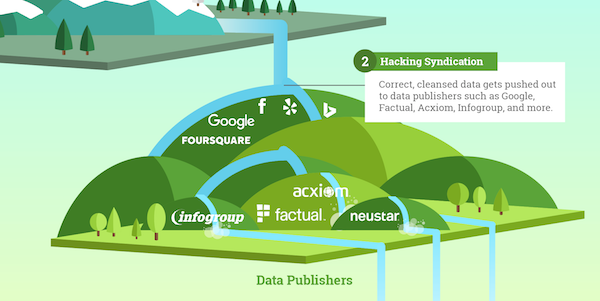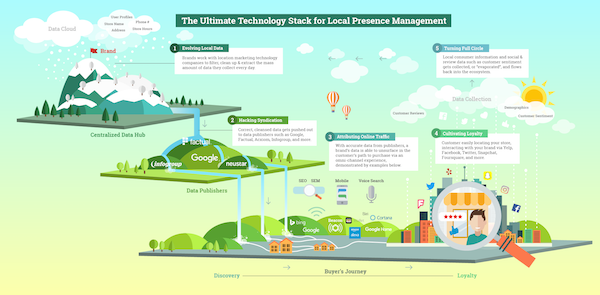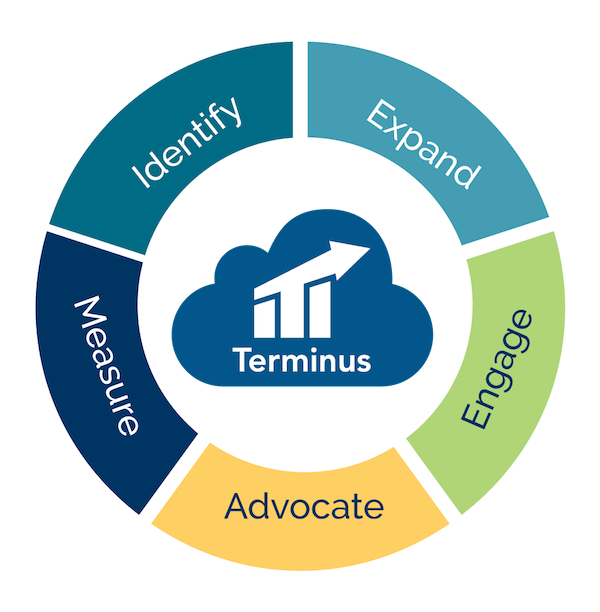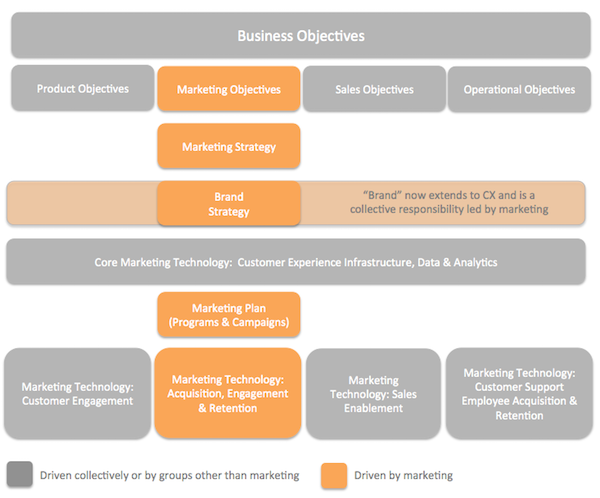This article is a guest post by Mila Hose and Mireya Prado (with graphics from Margaret To) of Brandify. It was entered into The Hackies essay contest for the upcoming MarTech conference. Like it? You can register your vote in the contest by sharing it on social media, especially LinkedIn, Facebook, and Twitter.
The idea that data should be at the core of all marketing strategies is not new, but for those who depend on in-store attribution for profitability, data plays a unique role in bridging the online to offline customer experience.
Enterprise marketers who manage campaigns for hundreds or thousands of locations are presented with the unique challenge of juggling data from a plethora of sources, from social platforms such as Facebook and Yelp, to search giants such as Google and Bing, in addition to brand-owned properties like location-specific landing pages.
1) Technology Stack Evolving Local Data
Data hovers in from each of these sources in the shape of store hours, address information, phone numbers, reviews and more. Marketers need technology to organize this data and redistribute it to the appropriate properties, while also optimizing key points for advertising purposes.
Rather than managing data across all of these individual platforms, marketers need a centralized data hub in which they can control location information across the digital ecosystem.
At Brandify, the brand data management technology provides infrastructure that verifies, updates and maintains the ever evolving location data. This brand data is cleansed for accuracy and consistency. Using deduplication features, marketers can find inconsistent location information across various search and social databases, eliminating duplicate listings and ensuring future data consistency. This helps streamline the maintenance of location data while evolving it for search.
2) Hacking Syndication and Claiming for Local
While accurate data is essential to any marketing strategy, this alone is not conducive to brand visibility. As a marketer, do you know which platforms your customers and prospects prefer to use? Do you have a presence on even the most obscure search and social networks? The number of people who say they use search engines to discover brands, products and services is decreasing, replaced, much in part, by the rise of social networks.
We ensure client visibility through partnerships with the top data aggregators, who then push cleansed brand data across the digital ecosystem to ensure the highest visibility across the web. In addition to core data publishers, such as Neustar, Factual, Infogroup and Acxiom, we also work with top search engines and social networks, such as Facebook, Google, Foursquare and more. These publishers ensure that a brand’s local information is available everywhere that users perform “near me” searches.
In order to reap the rewards of long-term brand visibility, marketers should focus on top-tier search engines and then layer on top aggregators that provide high-impact visibility across search and social platforms.
3) Attributing Online Traffic to Store Visits
Once your brand’s data has been cleansed and syndicated, optimizing the online to offline customer journey begins. In order to convert online traffic to in-store visit, brands must have technology that speaks to the strategy. The omni-channel experience, calls for layers of technology, demonstrated by the following examples:
SEO
Jim and Sally are looking for fast casual restaurants that are open past 11:00pm on a weeknight. They do a local search for “Chinese food open near me,” and choose one of the few options available so late.
They have never heard of the business before, but are willing to give it a try due to their limited options. They dine at the establishment and are impressed with the quality of service they receive, in addition to their delicious meal. They make plans to return the same weekend, and later tell their bingo club about their impressive experience.
SEM
Kim is looking for the perfect dress for her wedding. She has visited every wedding dress retailer in the area, tried on more dresses than she can count, and is about to finalize the decision for her favorite dress.
Before she visits the store, she does one last search for the store to look at the dress online, but finds another wedding dress retailer in the AdWords listing just before she clicks into the original site destination. Hesitant to make a decision before considering every option, she clicks the AdWords listing and ends up finding the dress of her dreams.
Mobile
Steven has narrowed down his choice between two similarly-priced, similarly-featured, pair of cleats, but can’t make a decision about which pair to buy. Each pair of shoes is being sold by a different retailer, neither of which has he ever purchased before. He pulls out his smartphone in the first store and begins looking through product reviews to help the decision process.
Suddenly, a mobile offer pops up, offering him a 18% discount if he makes his purchase in the next 10 minutes. With such an unbeatable offer, Steven hurries to the nearest register to seal the deal.
Conversational Commerce
On a road trip, Maria has been driving on a long country highway for quite a few hours when she realizes that she needs to refill her gas tank as soon as possible. Seemingly in the middle of nowhere, Maria activates the voice search on her smartphone to find out the distance of the nearest gas station. There is a gas station less than a mile away, but the brand is not optimized for voice search, so the option is never served up to Maria, and she is forced to keep driving toward the next closest location, hoping she doesn’t break down along the way.
4) Cultivating Loyalty in an Economy of Infinite Choice
Yet, once prospective consumers convert to real, in-store visitors, marketers still have work to do before cultivating them into loyal, returning customers. Mobile devices have provided customers with immediate access to an infinite list of choices, and when one brand fails to meet their expectations, another is instantly available to pick up the slack. Yet, even with so many options, research indicates that as many as 60% of consumers are brand loyal.
Much of a customer’s loyalty comes from the way a brand engages with them. Customers want to share their experiences with others, and they want brands to acknowledge their feedback, especially when things go wrong. For multi-location brands, the final marketing technology hack is finding a reputation management technology in which to implement a review response and/or social response strategy.
Users interact with brands on a number of different platforms, such as TripAdvisor, Facebook, Yelp and Foursquare, and it can quickly become overwhelming to manage all of these accounts, not for just one store, but for many locations.
For enterprise brands, it is critical to use a reputation manager that enables administrators to sort and manage reviews for all locations within a single dashboard, as well as the ability to both schedule social content and facilitate real-time conversations.
5) Turning Full Circle
As your brand demonstrates authenticity by engaging with customers, those customers will not only become more loyal, but contribute to your brand presence by sharing their experiences across search, social and review platforms. In turn, your brand can garner more leads and continue to broadcast your presence across the entire digital ecosystem.

Ultimately, the data gathered from these in-store visits is released back into the local ecosystem, and available for your brand to absorb and filter back through your digital location data hub. This data can be used to provide actionable analytics for benchmarking performance, retargeting customers and ultimately, retaining and discovering local customers.
What did you think of this article as an entry in The Hackies essay contest for the upcoming MarTech conference? If you liked it, you can register your vote in the contest by sharing it on LinkedIn, Facebook, and Twitter.








